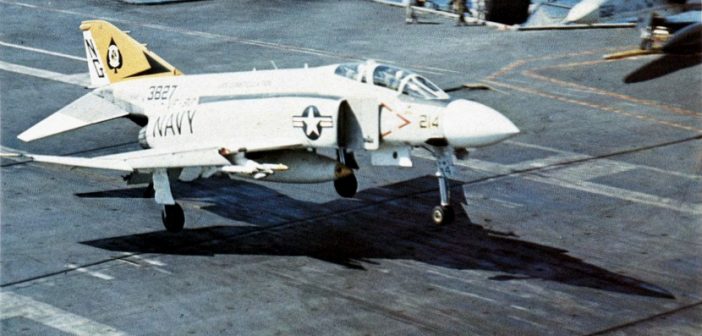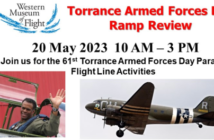(From the chapter entitled “Hell’s Invitations”, in Vietnam to Western Airlines, Volume II)
Like most wars, the Vietnam War was used as a testing ground for not only new weapons systems and technology, but for the study of the physiological and psychological effects of combat on flight crews. We had learned that earlier in the war Navy pilots had been wired up with all kinds of pulse and respiration monitoring equipment to record their reactions in combat and other environments. The startling discovery was that for Navy pilots, night carrier landings were far more stressful than actual combat.
To me this makes perfect sense. Day landings were challenging, exciting, and competitive, since we were graded on each landing and a running score was kept in the ready room. In combat things happen rapidly, and the physical adrenalin-aided response is mostly reactionary and forceful. Night carrier landings, however, are often preceded by time spent in a holding pattern in the pitch black followed by a long arcing turn to a long final; far too much time to contemplate all the things that could go wrong. Vertigo is an ever-present companion in a fighter at night, when you must turn and bank in that pitch-black environment. Focus on one’s instruments creates a claustrophobic and myopic tension. Once in close, on a pitch-black night, it becomes more difficult to pick up the movement of the ball or the drift of the airplane off centerline, especially if there is rain and a pitching deck. The vertiginous environment encountered during night carrier landings, especially with no horizon, no moon, and no stars, was simply terrifying.
It seemed that all the bad stuff that happened around the boat occurred at night. Midway through my first cruise an A-5 Vigilante with a crew of two had made two passes at the deck on a pitch-black night and had boltered (missed the wires) twice. He was low on fuel so the Air Boss told him to rendezvous with the tanker, which was orbiting the ship at 2500 feet. While in a left rendezvous turn trying to make out the blinking red lights of the tanker, he flew into the water. Not long after that that we learned that Jim Phiel, our most senior and respected RIO (Radar Intercept Officer) from our first cruise, while conducting night carrier qualifications aboard USS Saratoga off the East Coast, had been in the back seat of an F-4 that experienced a “Cold Cat Shot.” In other-words there had been some malfunction of the catapult or aircraft that resulted in insufficient flying speed. Again, there were no survivors and we mourned the loss of a dear friend and an exceptional leader. Jim had been groomed to become the first non-pilot to command a fighter squadron.
It was on one of these dark, moonless, overcast nights that my RIO Harry Hunter and I got another terrifying “Invitation” when, after a routine mission, we decided to do an ACLS (Automatic Carrier Landing System) approach. This system involved the ship’s computer taking control of our aircraft and guiding it down an imaginary glide slope to a landing on the deck. We had an auto throttle system to control airspeed, and when and if all worked well, it usually gave us a 3 wire. Normally we hated to do these approaches, but the squadron needed the aircraft to be certified regularly and this aircraft hadn’t performed one in quite some time. After our arching-turn we intercepted the inbound radial and descended to 1200 feet. We dirtied up (gear, flaps and hook down) and slowed to approach speed. When I coupled up the system (engaged autopilot and auto-throttles) the line-up needle was centered and the glideslope needle was pegged high. As we approached the glideslope from below, the needle began to move down. As it approached the center, the aircraft was supposed to intercept the glideslope and begin a descent to center the needle and follow it down the glide path. But the aircraft stayed level at 1200 feet and the needle went low, indicating I was drifting well above the glide slope.
“Shit, this thing’s not capturing the glide slope,” I said to Harry. “I’m going to have to…”— but before I could finish my sentence, the nose pitched violently down, chasing the needle and lifting us off our seats and against the shoulder harness straps. My guess is that we were pointed at least 25-30 degrees nose down, heading for the water, before I could disconnect the autopilot. A 25-degree nose down attitude may not seem like a lot, but when you are low, slow, and dirty at approach speed, can’t see anything outside and have to recover, it gets your attention in a big way. I immediately slammed the throttles full forward and pulled back to my optimum angle of attack. I couldn’t see the water, the horizon, or anything outside the cockpit. I suspected it was too late to eject at this angle and rate of descent. The radar altimeter was unwinding and I moved the throttles to afterburner knowing that more thrust would let me pull harder without stalling the aircraft. This lit things up behind us and really got the attention of the folks looking toward us from the ship. We bottomed out at about 200 feet and I climbed back up to the glideslope and hand-flew the approach from there on in, determined to get aboard and not to have to go around and try this again. When we shut down the engines and climbed out my hands were shaking uncontrollably. Of course, I downed the aircraft, but I decided that the next night I would have to try another ACLS approach or I might never have the nerve to do one again. That night all went as advertised, but I don’t think I ever attempted another one after that.
Someone had been doing some pretty effective prayerful work for our protection, and it hadn’t been me. I resolved to express my gratitude for that protection and to do my part as well. Many years later when my mother wrote and published her memoirs, “A Dance and a Hug”, which can be found on her website, www.marjorielord.com, she spoke of the constant prayer she had done with regard to my protection. I had never told her of the most harrowing experiences, as she was the last one, I wanted to beset with worry, but somehow, she knew and her spiritual support came through.




